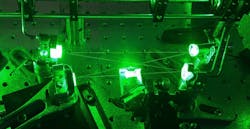Diamond Brillouin laser could generate millimeter-wave frequencies for next-gen radar
Researchers from Macquarie University (Macquarie Park, Australia) have discovered a novel and practical approach to Brillouin lasers (lasers that incorporate light/sound interaction for light amplification), in the form of diamond lasers that have an output power ten times higher than any other Brillouin laser.1 Until now, lasers have been low in power—and often seen as a curiosity. Indeed, in many systems such light/sound interaction is seen as a nuisance because the effect spoils laser system performance as power is increased.
Diamond is a particularly interesting material for this type of laser: Its high thermal conductivity makes it possible to create miniature lasers that simultaneously have high stability and high power; in addition, the speed of sound in diamond is also much higher than in other materials, giving the laser a secondary ability to directly synthesize frequencies in the hard-to-reach millimeter-wave band.
The new laser, the first bench-top Brillouin laser that uses diamond, provides a practical approach to Brillouin lasers with an increased range of performance. In contrast to earlier Brillouin lasers, the diamond version operates without having to confine the optical or sound waves in a waveguide to enhance the interaction. As a result, these lasers can be more easily scaled in size and have greater flexibility for controlling the laser properties as well as increasing power.
Only a very small amount of waste energy is deposited in the diamond sound-carrying material, which leads to features including beam generation with ultrapure and stable output frequency, the generation of new frequencies, and potentially, lasers with exceptionally high efficiency.
"This development provides a new pathway towards high-power lasers that are extremely efficient and have exquisite frequency properties such as low phase noise and narrow linewidth," says Macquarie University's Rich Mildren. "These are properties needed for applications that demand the highest standards of noise-free frequency properties, like ultra-sensitive detection of gravitational waves or manipulating large arrays of qubits in quantum computers."
18 km/s speed of sound in diamond
As a consequence of the very high speed of sound in diamond (18 km/s), the frequency spacing between the input pump beam and the laser line is many times higher than in other materials; this property can be used to generate frequencies in the millimeter-wave band (30-300 GHz) via photomixing. Brillouin laser synthesis of these frequencies is important because there is an intrinsic mechanism that reduces the frequency noise to the levels needed by next-generation radar and wireless communication systems. This has been a major challenge for electronics or other photonic-based generation schemes.
The diamond Brillouin laser produces more than 10 W of optical power. The authors next want to demonstrate lasers with the higher levels of frequency purity and power needed to support future progress in quantum science, wireless communications, and sensing.
Source: https://www.scimex.org/newsfeed/a-sound-boost-to-extreme-laser-performance
REFERENCE:
1. Zhensu Bai et al., Applied Physics Letters Photonics 5, 031301 (2020); https://doi.org/10.1063/1.5134907.
About the Author
John Wallace
Senior Technical Editor (1998-2022)
John Wallace was with Laser Focus World for nearly 25 years, retiring in late June 2022. He obtained a bachelor's degree in mechanical engineering and physics at Rutgers University and a master's in optical engineering at the University of Rochester. Before becoming an editor, John worked as an engineer at RCA, Exxon, Eastman Kodak, and GCA Corporation.

